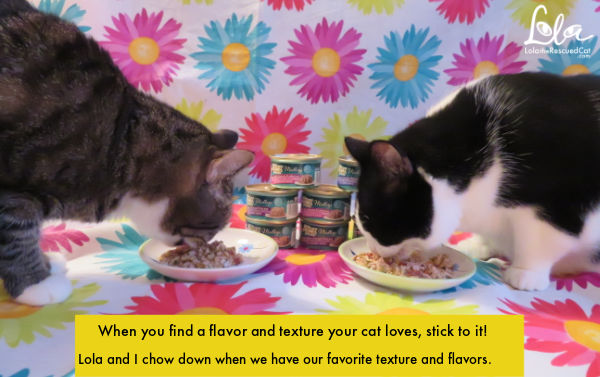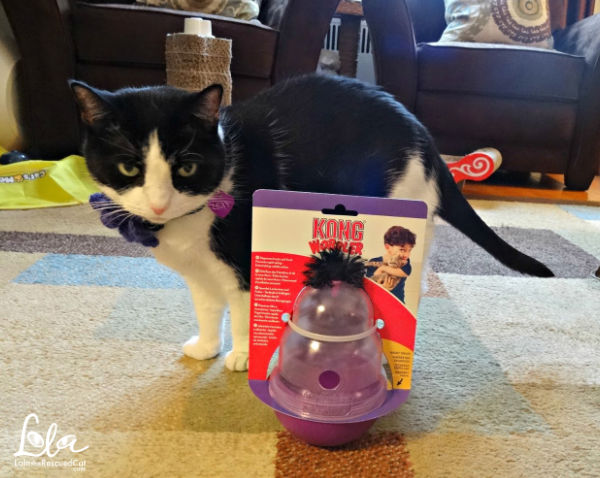Lola and Lexy’s Top Five Tips to Get Your Finicky Cat to Eat
Lola and Lexy's Top Five Tips to Get Your Finicky Cat to Eat
Stick to a Texture Your Cat Likes
"It may be that the cat really does prefer a particular texture or flavor of food." - Drs. Williams and Downing
Doctors Williams and Downing also state that “pet owners can actually help to create a fussy eater by taking advantage of the huge variety among cat foods." So when you find a flavor and texture your cat loves, stick to it.
Here in the White house, there is no pate on the menu because both Lola and I do not like that texture. There is also no seafood on the menu. Our preference is grilled variety in poultry flavors, with an occasional beef. Mother sticks to this so we both have a healthy diet.
Have a Regular Feeding Schedule
Cats need to be hungry to eat their food. If you are free-feeding or giving your cat many treats throughout the day, the problem could be that they are just not hungry!
Try to resist the temptation to leave a bowl full of kibble out for your cat to nibble on throughout the day. Instead, implement a regular schedule. This could be feeding twice a day at regular times or portioning out the food into several smaller meals.
Lola and I eat breakfast and dinner. Breakfast time usually depends on Mother’s schedule, but it’s normally between 7am and 8am. Dinner is promptly at 8pm. We’ve meowed in the past about Lola being somewhat of a picky eater, but let me tell you… she’s chowing down on dinner after waiting 12 hours between meals.
If you’re not going to be home for many hours, you can still feed smaller portions with an automated feeder. https://amzn.to/3iVZwYk The Cat Mate Bowl is battery operated, has two bowl sections, and also comes with ice packs to help keep food fresh.
Jackson Galaxy makes a good point: if a human snacks all day, are they motivated to eat their dinner? The same goes for your cat.
"To put it in a human perspective: if you were snacking all day, would you be motivated to eat dinner when it was time? With that in mind, if your cat has food sitting out 24/7, do you think she is going to be that motivated to try something new?" - Jackson Galaxy
Remember, Location is Important
Take a look at where your cat’s food bowl is. Cats want to eat in a safe location where they don’t have to worry about other pets in the house sneaking up on them. We like to eat where we can see the goings-on in the house. (Your can may choose to go without their meal if they do not feel safe.) https://ift.tt/37GhoV5
Lola likes to eat in the living room and prefers to be facing the room. She very rarely eats with her back to the room. Mother makes sure she has enough room behind the dish so she can sit and enjoy a relaxed meal.
You can also try feeding in different locations where your cat will feel safer. The cat tree, a shelf, inside a box, or in another room, are all places you can try. Lola wants to make sure we let you all know to listen to your cat. Lola will tell Mother where she wants to eat. Sometimes it’s in the kitchen, sometimes the living room, and often she wants her meals served on the window sill. Sometimes humans need to be a detective.
Another important tip about location; your cat’s food bowl should never be near the litter box. I mean, would you eat your lunch in the bathroom? I didn’t think so.
Make Mealtime Fun
Just because your furry loved one is an indoor cat doesn’t mean they don’t have to fulfill their natural instinct to hunt for their food. A great way to imitate hunting behavior is to use food puzzle toys. Your cat may get excited “catching” their own meal and gobble it up.
Another mealtime fun tip is to hide food in different places, like a trackball toy (this is one of Lola's favorites) or on her favorite perch. You can also play with your cat right before mealtime with a wand toy to mimic “the hunt.” After your cat captures the prey at the end of the wand, present her with a yummy meal.
Appeal to Your Cat's Sense of Smell
If you are serving room temperature food that your cat is turning their nose up at, try warming that as well. Warming the food releases the “meaty” smell, and could very well have something to do with your cat’s predatory nature.
Adding some chicken broth (no salt or spices added), a little tuna juice (packed in water, not oil), or a little sprinkle of parmesan cheese on the top of the food may appeal to your cat’s sense of smell and encourage them to eat.
A Word of Caution
Getting into a power struggle with your cat is not going to make them eat, and withholding food in an attempt to spark their appetite or entice them to eat is not a good idea. Doctors Williams and Downing warn cat parents that “if a cat has any predisposition at all, just a few days of not eating can cause a potentially fatal condition called hepatic lipidosis.”
Always consult with your veterinarian anytime your cat refuses to eat or is exhibiting changes in their eating patterns.
 |
| Pin Us! |
Do you have any tips for tempting a finicky feline to eat? We’d love to read them in the comments.
Lola and Lexy
Sources:
Arnold, Brooke. “Tips & Tricks for Getting a Finicky Cat to Eat.” The Catington Post, 14 Sept. 2020, catingtonpost.com/tips-tricks-for-getting-a-finicky-cat-to-eat/.
Krieger, Marilyn. “What Some Call ‘Finicky Eating’ Could Be a Cat Behavioral Issue.” Catster, 16 Dec. 2016, https://ift.tt/3ktBh5m.
Williams, Krista, and Robin Downing. “My Cat Won't Eat: Feeding Picky Eaters.” VCA Hospitals, vcahospitals.com/know-your-pet/feline-picky-eater.
“Help for the Finicky Cat & the Exasperated Human.” Jackson Galaxy, 24 Dec. 2019, https://ift.tt/37Cnkym.







Post a Comment